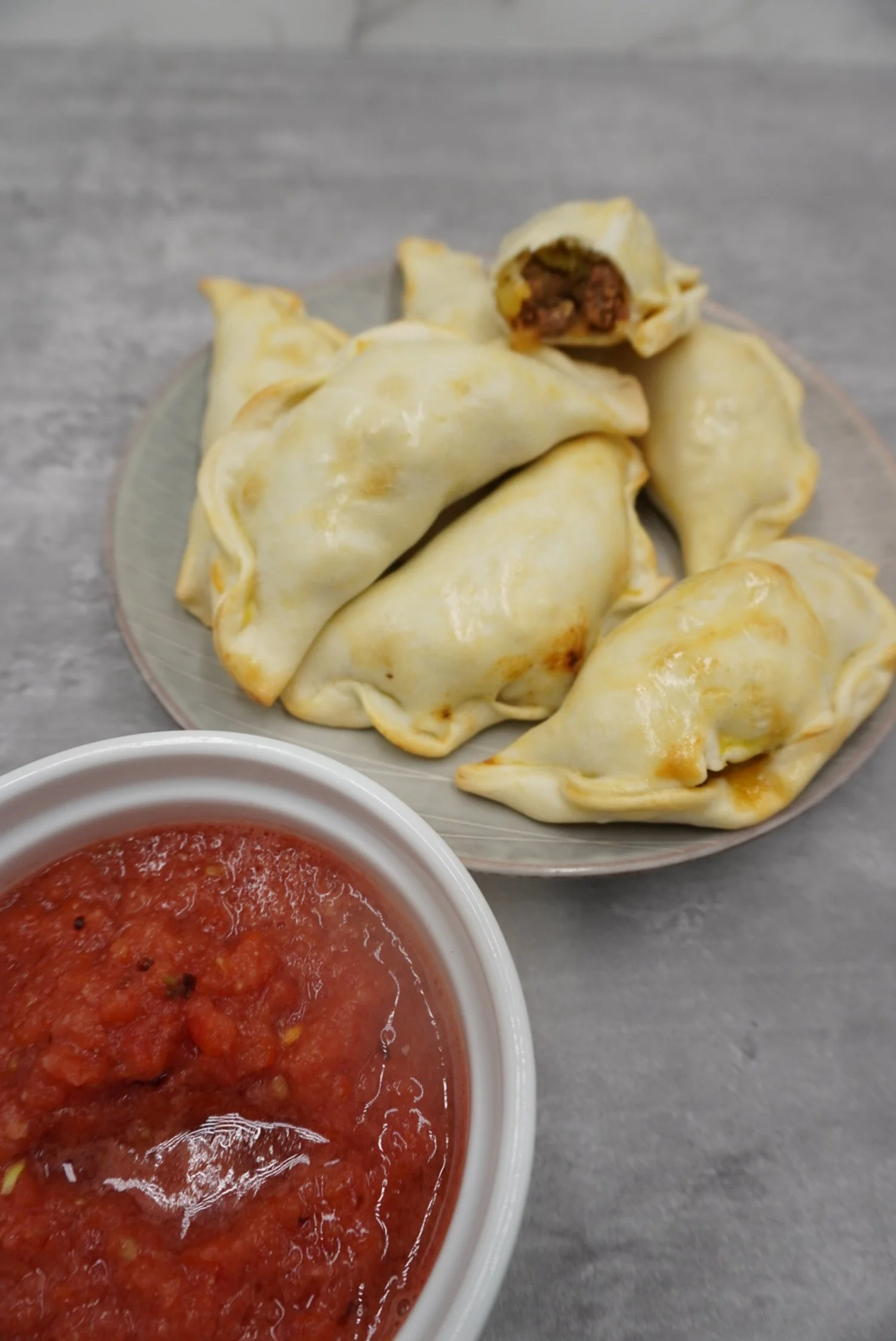This Food in History #10 Empanadas
Hello! I’m Soph and welcome to another episode of This Food in History!
This month we are looking at a simple food with many names and different associations and variations. Empanadas! At work one of my coworkers returned from Jamaica and one of my top questions as he is also a foodie like me (and an excellent baker) is if he had tried something that is also my dad’s favorite treat, beef patties.
He didn’t but we joked about how it’s basically just spicy empanada and had a moment together about how many countries seem to have their own version of empanadas and often with different names, same concept. Now here we are looking up the history of Empanadas.
Empanada comes from the verb empanar which is a very specific verb that means to wrap or coat in bread according to almost all of my cites, but means to tarnish according to Google translate but not when I google it.. Which is perfect since an Empanada is made from folding meat, veggies, cheese, apples and more in dough or bread.
So who had it first? The earliest known records I was able to find while looking come out of Persia in 100 BC. We have multiple names already coming out of this time as making pastry expanded around the regions as Alexander the Great was gathering up property across Asia Minor and Northern Africa. They include sfiha, fatayer, samosas, and piroshki.
Sfiha is an open face meat pie and is similar to a pizza with a minced meat topping. They come from Levant. Levant is a historical region in the Eastern Mediterranean involving the modern day countries of Lebanon, Syria, Israel, Jordan, Iraq, and Kuwait.
Fatayer comes from the same regions and is usually stuffed with spinach, cheese, not meats like Sfiha.
Samosas are out of South Asia from India and Middle Eastern areas and is a savory pasty that is enclosed.
Piroshki is the odd man out with a more Eastern European origin stuffed bun.
So how did we get from these to empanadas being so Spanish or Latin in today’s society?
Starting in 711 AD we have the moors (Muslims) invading Spain and ruling there for about 800 years. They brought these pastries with them and so by 1520 we see a cookbook published in Catalan with seafood based empanadas. Galicia (Spain) and Portugal, and Medieval Iberia are now making something inspired by French, Arabian, Catalan, and Italian pastries and was initially made as one big pie that would be cut into individual servings. Chicken and tuna were the most popular flavors.
Next we see Spanish colonists bringing them with them to Latin America and the Philippines. They shared their empanada recipe with the Aztecs and Maya and as the recipes and food spreads we see regional variations that explode all over South America and the Philippines based on available ingredients and produce. The biggest most consistent change that developed was the change of the sliced pie version to individual hand pies. It seems to be favored as it has survived all the hundred of years. In Argentina, it was known as a working man’s meal because empanadas studded to the brim with personal choices in flavor were basically a full meal that was easy to carry to work.
In Belize, empanadas are known as panades. They are made with corn dough called masa and typically stuffed with fish, chicken, or beans. They are usually deep fried and served with a cabbage or salsa topping.
In Brazil, an empanada is called a pastel and consists of half-circle or rectangle-shaped thin crust pies with assorted fillings, fried in vegetable oil. The result is a crispy, brownish fried pie. The most common fillings are ground meat, mozzarella, catupiry, heart of palm, codfish, cream cheese, chicken and small shrimp. Pastéis with sweet fillings such as guava paste with Minas cheese, banana and chocolate also exist.
Empanadas are a staple part of Chilean cuisine. Commonly consumed in large quantities during the country's national day celebrations, many Chileans consider this to be their most representative dish. The most representative variety being the oven-baked empanada de pino, which is filled with ground beef, minced onion, half or a quarter of a hard-boiled egg, and a single unpitted black olive.
El Salvador is one of few countries where the empanada is made with plantain rather than a flour-based dough wrapping. A popular sweet variation, empanadas de platano are torpedo-shaped dumplings of dough made from very ripe plantains, filled with vanilla custard, fried, then rolled in sugar.
In Indonesia, empanadas are known as panada. They are especially popular in Manado cuisine of North Sulawesi where their panada has a thick crust made from fried bread, filled with spicy cakalang fish (skipjack tuna) and chili, curry, potatoes or quail eggs. The panada in North Sulawesi was derived from Portuguese influence in the region. The dish is similar to karipap and pastel, although they have a thinner crust compared to panada.
Filipino empanadas usually contain ground beef, pork or chicken, potatoes, chopped onions, and raisins (somewhat similar to the Cuban picadillo), in a somewhat sweet, wheat flour bread. There are two kinds available: the baked sort and the flaky fried type. To lower costs, potatoes are often added as an extender, while another filling is kutsay
Dessert versions of empanadas also exist, notably empanaditas, which commonly have a filling of latik (coconut caramel), honey and nuts, or peanut butter. Kapampangan versions of empanaditas have a yema (custard) and cashew nut filling. In Cebu, sinudlan empanada is a small deep-fried empanada with bukayo (sweetened coconut meat) filling
For Colombia, one of the most popular dishes is corn flour empanadas. They can be filled with either meat or vegetables, and they are always delicious. Ground beef, onions, potato.
There are many more variations in so many parts of the world today including Italian calzones, Jamaican beef patties, British pasties, Scottish bridies and the even older Chinese dumplings and gyoza that spread from Cantonese immigrants into America.
Whatever you call them, empanads, patties, pasties, dumplings, meat pies, pandas, you can find this treat all over the world with many varieties and tastes to enjoy. We even have a National Empanada Day on April 8th that much of the world recognizes. I’ll leave you on this fun fact that Cubans eat more empanadas than any other nation according to stats and consume them at any mealtime. This has been This Food in History, please like and subscribe if you’d like to see more of these and hit that bell to catch my sporadic video drops and cooking shorts!
Cites:
https://www.pappydevilcrabs.com/everything-you-need-to-know-about-empanadas/
https://theculturetrip.com/south-america/argentina/articles/a-brief-history-of-the-empanada/
https://www.elsursf.com/news-item/a-brief-history-of-empanadas/
https://www.tastingtable.com/1000518/the-migratory-history-of-the-empanada/
https://originalempanadafactory.com/the-history-of-the-empanada
https://www.quebrachomn.com/blogs/minnesota-empanada-blog/understanding-the-history-of-empanadas
https://www.locogringo.com/blog/food/history-empanada-happy-empanada-day
https://www.slurrp.com/article/the-history-of-empanadas-the-south-american-snack-1645464111923
https://www.bbc.co.uk/food/recipes/jamaican_beef_patties_28917
https://dinas-kitchen.com/2018/03/24/sfiha-armaniyye-meat-pizza-armenian-way/
https://www.kingarthurbaking.com/recipes/fatayer-middle-eastern-savory-hand-pies-recipe
https://www.sweetandsavorybyshinee.com/russian-piroshki-meat-hand-pies/
https://www.ducksters.com/history/islam/islamic_spain_al_andalus.php
https://www.manzanillosun.com/the-conquest-of-the-aztecs-1521/
https://www.tablespoon.com/recipes/chilean-empanadas-with-beef/e65df713-2d34-4bab-b25b-e0bfc5db6823
https://www.recetassalvador.com/recetas/reposteria/empanada-de-platano-con-frijoles




